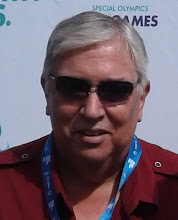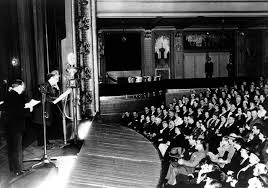It's Murder, He Painted: The Way It Was, 2 March
FEATURED BROADCAST
SUSPENSE:
PORTRAIT WITHOUT A FACE
(CBS, 1944)
SUSPENSE:
PORTRAIT WITHOUT A FACE
(CBS, 1944)
The painter (Philip Dorn) of an admired and mysterious portrait thinks the former lover (Michelle Morgan) he painted is the woman who assassinated an aviation-minded general slandered as a criminal in prewar France---a woman whose husband (George Coulouris), a Nazi collaborator, has sent her to try luring him to his own death.
Additional cast: Unknown. Story: Louis Peletier.
AIRWAVES . . .
1897: ONE SMALL STEP FOR MARCONI---Guglielmo Marconi---whose interest in electricity was renewed by published reviews of Heinrich Hertz's discoveries of radio waves (electromagnetic radiation), and who has studied with Augusto Righi, who worked as a Hertz researcher---receives the first known wireless patent, from the government of Great Britain, almost a year after he first filed for the patent.
After experiments of his own, many of which are done in his Pontecchio, Italy home and aim at transmitting telegraph messages without needing connecting wires, an idea many have tried with no commercial success previously, Marconi will develop a so-called spark-gap radio transmitter (based on one designed earlier by Righi), a telegraph key sending impulses based on the Morse code, a more reliable variant of Edouard Branley's coherer receiver, and a telegraph register to record the key's Morse code transmissions.
Two years before receiving his patent, Marconi experimented outdoors, with longer transmitter and receiver antennae arranged vertically, and discovered that each touching the ground resuled in a greater transmission range---and began transmitting signals at least a mile away, convincing him (according to several sources) that with more research and finance his devices might reach greater distances and prove viable in commercial and military terms alike.
Officially, the Marconi patent is known as British patent GB12039, "For Improvements in Transmitting Electrical Impulses and Signals, and in Apparatus Therefor" (original spelling)---considered in due course to be the first known radio communication patent in the world. In due course, there will be debate as to whether or not Marconi's devices were patentable since they advance and actualise the earlier discoveries of Hertz and others. (This, of course, foreshadows 21st century arguments over whether certain technologies related to the Internet can be patentable because they, too, advance and actualise prior art.)
Marconi will refuse an offer to sell the rights to his work by the British post office. Over four months after receiving the wireless patent, Marconi will form the Wireless Telegraph and Signal Company, Ltd. and serve as a director and chief engineer. Three years afterward, he renames the company Marconi's Wireless Telegraph Company, Ltd.---a year after he opened a branch in the United States . . . the branch for which a young man named David Sarnoff, the future founder of the National Broadcasting Company, would as a telegraph operator, gaining initial fame for picking up distress reports tied to the sinking Titanic.
Indeed, the Titanic disaster will help revive the Marconi companies, which lost money during their establishment years. (The doomed ship's two radio operators were employed, in fact, not by the White Star Line but by Marconi International Marine Communication Company; Marconi himself would testify, to a Court of Inquiry investigating the Titanic disaster, about marine telegraphy and its sea emergency procedures.)
By 1912, however, American Marconi will sell its assets to the General Electric Company under pressure from Washington, thanks to its being considered a near-monopoly following its absorption of bankrupt United Wireless. GE will use the Marconi assets to form RCA---where Marconi fast-key artist Sarnoff will rise to become the new company's general manager, during which time he forms NBC as an RCA subsidiary.
Marconi's career will conclude in controversy. First, his company will come to be seen as somewhat slow when continuous wave transmission becomes the wave of the future around, though the Marconi companies finally begin working with such transmission and, in fact, set up the first known entertainment radio broadcasts in England, preluding the Marconi enterprise's participation in the founding of the British Broadcasting Corporation in 1922.
But a year later he joined Italy's Fascist party, and received an appointment from Mussolini as president of Accademia d'Italia (The Academy of the Lynxes, a prominent Italian science institution) in 1930. His public defence of Mussolini's invasion of Ethopia will get him barred from speaking on the subject over the BBC.
Notwithstanding, Marconi's death in 1937---he was twice married and the father of three daughters and a son (a fourth daughter died in infancy)---will be observed by old-time radio stations worldwide, with two minutes of silence, in memory of the man who fathered radio, even if it had several grandfathers.
CHANNEL SURFING . . .
THE SHADOW: DEATH RIDES A BROOMSTICK (MUTUAL, 1941)---On the two hundredth anniversary of a curse said to be blurted out in rage---by a woman against her executioner, before she's burned as a witch---Lamont Cranston (Bill Johnstone) and Margot Lane (Marjorie Anderson) try to prove the innocence of the executioner's great-great-grandson, who fears the curse has taken effect . . . and who's just been broken away from custody on his way to a life sentence for his brother's murder. Additional cast: Unknown. Announcer: Ken Roberts. Writer: Possibly Walter B. Gibson. (Advisory: Several moments of echoing and skipping are present in the second half of the surviving recording.)
THE FRED ALLEN SHOW: MURDER IN THE PENTHOUSE (NBC, 1947)---The Quiz Kids (Joel Kupperman, Lonnie Lundy, Naomi Cook, Jack Rooney) join the Allen-Benny feud in their way and prompt Fred (Allen) to imagine them starring in a radio mystery, after the Alley demimonde discusses their favourite portions of the daily newspaper. With Portland Hoffa. Claghorn: Kenny Delmar. Titus: Parker Fennelly. Mrs. Nussbaum: Minerva Pious. Ajax: Peter Donald. Music: Al Goodman Orchestra, the Five DeMarco Sisters. Writers: Fred Allen, possibly Robert Schiller, possibly Bob Weiskopf.
PREMIERING TODAY . . .
1902---Dame Flora Robson (actress: Streets of Pompeii [BBC]), Brighton, U.K.
1904---Theodore (Dr. Seuss) Geisel (writer: American School on the Air; Columbia Workshop), Springfield, Massachussetts.
1909---Mel Ott (nickname: Master Melvin; baseball player/manager turned sportscaster: Detroit Tigers play-by-play), Gretna, Louisiana.
1917---Desi Arnaz (as Desiderio Alberto Arnaz y de Acha III; bandleader: The Bob Hope Show), Santiago, Cuba.
1918---Elmira Roessler (actress: Ma Perkins; Mary Noble, Backstage Wife), St. Louis.
1919---Jennifer Jones (actress: Radio Hall of Fame), Tulsa, Oklahoma.
1904---Theodore (Dr. Seuss) Geisel (writer: American School on the Air; Columbia Workshop), Springfield, Massachussetts.
1909---Mel Ott (nickname: Master Melvin; baseball player/manager turned sportscaster: Detroit Tigers play-by-play), Gretna, Louisiana.
1917---Desi Arnaz (as Desiderio Alberto Arnaz y de Acha III; bandleader: The Bob Hope Show), Santiago, Cuba.
1918---Elmira Roessler (actress: Ma Perkins; Mary Noble, Backstage Wife), St. Louis.
1919---Jennifer Jones (actress: Radio Hall of Fame), Tulsa, Oklahoma.












0 Comments:
Post a Comment
Subscribe to Post Comments [Atom]
<< Home